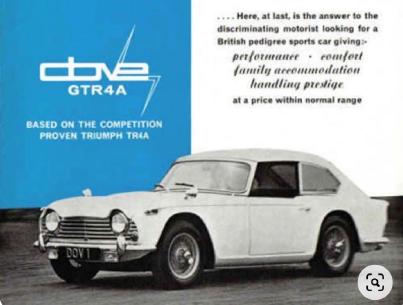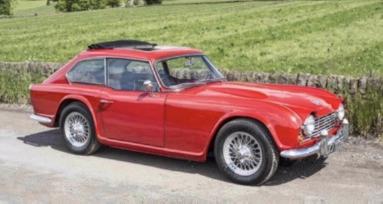
DID – U – KNOW
by Facia Nearside
 Following WWII what was left of the Triumph Motor Company was bought by the Standard Motor Company. Triumph’s Holbrook Lane works had been completely destroyed by bombing in 1940 so pre-war Triumph models were not revived. Instead, beginning in 1946, Standard announced a new range of cars beginning with the Triumph Roadster. This was followed by the TR2 in 1953, then the TR3 in 1955. Although both were well received, by the late 1950s enthusiasts were beginning to expect a little more comfort along with Following WWII what was left of the Triumph Motor Company was bought by the Standard Motor Company. Triumph’s Holbrook Lane works had been completely destroyed by bombing in 1940 so pre-war Triumph models were not revived. Instead, beginning in 1946, Standard announced a new range of cars beginning with the Triumph Roadster. This was followed by the TR2 in 1953, then the TR3 in 1955. Although both were well received, by the late 1950s enthusiasts were beginning to expect a little more comfort along with
 the sporting image. Side curtains were giving way to roll up windows, doors actually had handles on the outside, and hoods could fold, no longer the need for those with an open two-seater to erect their top like a tent.
the sporting image. Side curtains were giving way to roll up windows, doors actually had handles on the outside, and hoods could fold, no longer the need for those with an open two-seater to erect their top like a tent.
 This trend was not lost upon Triumph and in 1961 the TR4 was announced. The mechanicals of the car were similar to the TR3, but a modern Italian styled body replaced the previous coachwork. In 1962, the first full year of production, the TR4s’ new look proved very popular with almost 16 thousand cars being built. This is even more noteworthy realizing Triumph had beat its chief rival’s new sports car to the marketplace. The MGB was still almost a year away. This trend was not lost upon Triumph and in 1961 the TR4 was announced. The mechanicals of the car were similar to the TR3, but a modern Italian styled body replaced the previous coachwork. In 1962, the first full year of production, the TR4s’ new look proved very popular with almost 16 thousand cars being built. This is even more noteworthy realizing Triumph had beat its chief rival’s new sports car to the marketplace. The MGB was still almost a year away.
 As good as all these improvements were there was one more step available in comfort and versatility, a closed car. Not everyone’s idea of sporting fun is the wind in their hair. This fact was a key part of the success at Jaguar. Beginning in 1951 the XK120 and its successors were available in both open and closed form. Jaguar followed with the E-Type in 1961 which from the start was built as an open or closed car in almost equal numbers. Longtime Triumph dealer L. F. Dove of Wimbledon recognized this appeal of a long-distance tourer and commissioned a conversion based upon the very successful TR4. The result was a unique car with attractive As good as all these improvements were there was one more step available in comfort and versatility, a closed car. Not everyone’s idea of sporting fun is the wind in their hair. This fact was a key part of the success at Jaguar. Beginning in 1951 the XK120 and its successors were available in both open and closed form. Jaguar followed with the E-Type in 1961 which from the start was built as an open or closed car in almost equal numbers. Longtime Triumph dealer L. F. Dove of Wimbledon recognized this appeal of a long-distance tourer and commissioned a conversion based upon the very successful TR4. The result was a unique car with attractive
 styling, the Dove GTR4. The high quality of the craftsmanship involved in the conversion resulted in the model two factors were considered to be a deal breaker preventing mass production. It was believed the car would be in direct competition with Triumph’s own Spitfire GT thus diluting its sales, and the final price after conversion approached that of a Jaguar E-Type. Ultimately only about 50 GTR4s were built. Triumph enthusiasts could once again feel smug, however. The Triumph GTR4 was available four years before the MGB-GT.
styling, the Dove GTR4. The high quality of the craftsmanship involved in the conversion resulted in the model two factors were considered to be a deal breaker preventing mass production. It was believed the car would be in direct competition with Triumph’s own Spitfire GT thus diluting its sales, and the final price after conversion approached that of a Jaguar E-Type. Ultimately only about 50 GTR4s were built. Triumph enthusiasts could once again feel smug, however. The Triumph GTR4 was available four years before the MGB-GT.
Editor Note: Article previously published in British Boots and Bonnets newsletter, August 2022
|